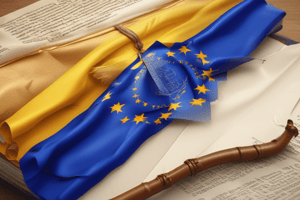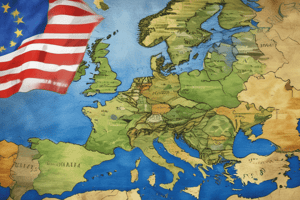Podcast
Questions and Answers
According to the content, what makes defining the European Union (EU) challenging?
According to the content, what makes defining the European Union (EU) challenging?
- The EU falls between being a typical international organization and a federal superstate, defying simple categorization. (correct)
- The definition of the EU is very simple.
- The EU precisely mirrors the structure of a federal United States of Europe, fitting neatly into existing categories.
- The EU strictly adheres to the characteristics of a standard international organization, making it difficult to distinguish.
What is meant when an author refers to the EU as sui generis?
What is meant when an author refers to the EU as sui generis?
- It functions as a standard intergovernmental organization.
- It is a unique entity that defies simple classification. (correct)
- It is easily classifiable under traditional international relations theory.
- It has a well-defined political and economic label.
What is the central argument regarding the EU's 'democratic deficit'?
What is the central argument regarding the EU's 'democratic deficit'?
- There is an agreement between critics and supporters that the EU's institutions are fully responsible and transparent.
- Critics unanimously agree that creating more elected offices will resolve all issues of democratic deficit.
- Critics argue the EU institutions lack sufficient accountability and transparency, while others contend the EU isn't a federal superstate, thus is accountable via member states. (correct)
- The European Parliament is solely responsible for representing the voters.
How has the approach to understanding the EU evolved since the 1990s?
How has the approach to understanding the EU evolved since the 1990s?
What recent trend has emerged in the EU related to globalization and emigration?
What recent trend has emerged in the EU related to globalization and emigration?
According to the content, what is the most accurate description of the EU?
According to the content, what is the most accurate description of the EU?
According to the content presented, what is a defining characteristic of decision-making within the EU?
According to the content presented, what is a defining characteristic of decision-making within the EU?
Which institutions of the EU are described as having 'federal qualities'?
Which institutions of the EU are described as having 'federal qualities'?
What policy areas within the EU have experienced a 'federalizing tendency'?
What policy areas within the EU have experienced a 'federalizing tendency'?
According to the content, what is a fundamental attribute of a sovereign state?
According to the content, what is a fundamental attribute of a sovereign state?
How is the independence of states qualified?
How is the independence of states qualified?
What contributes to the weakening of public loyalty to the state?
What contributes to the weakening of public loyalty to the state?
What is most threatened by globalization?
What is most threatened by globalization?
What has been a reaction caused by globalization?
What has been a reaction caused by globalization?
Which factor has historically driven interstate cooperation in Europe?
Which factor has historically driven interstate cooperation in Europe?
What characterized the decision-making process in the European Coal and Steel Community (ECSC) and the European Economic Community (EEC)?
What characterized the decision-making process in the European Coal and Steel Community (ECSC) and the European Economic Community (EEC)?
What does 'regional integration' involve?
What does 'regional integration' involve?
When EU institutions negotiate on behalf of member states with third parties, what policy area are they working in?
When EU institutions negotiate on behalf of member states with third parties, what policy area are they working in?
According to the content, what do the European Council and the Council of the EU represent?
According to the content, what do the European Council and the Council of the EU represent?
After 1945, what shift occurred in the motives driving interstate relations in Europe?
After 1945, what shift occurred in the motives driving interstate relations in Europe?
Flashcards
What defines a state?
What defines a state?
A state is a legal and political entity with a government, population, territory, and sovereignty.
International Organization
International Organization
Cooperation among states based on voluntary membership, communal management, and joint decision-making.
Nationalism
Nationalism
A group of people with a shared identity that should have its own state and self-governance.
Supranationalism
Supranationalism
Signup and view all the flashcards
Regional Integration
Regional Integration
Signup and view all the flashcards
Defining the EU
Defining the EU
Signup and view all the flashcards
Intergovernmentalism
Intergovernmentalism
Signup and view all the flashcards
EU Trade Policy
EU Trade Policy
Signup and view all the flashcards
Democratic Deficit in the EU
Democratic Deficit in the EU
Signup and view all the flashcards
Study Notes
Defining the European Union
- Defining the EU is complex because it surpasses a standard international organization such as the UN or WTO.
- It is also not a federal United States of Europe or a European superstate.
- Scholars define the EU through terms like multi-level governance, or describe it as sui generis (unique).
- Agreeing on a definition for the EU is difficult and has broad implications, notably regarding public opinion.
- Example implication is the democratic deficit; critics view EU institutions as irresponsible and resist creating more elected offices fearing a federal Europe.
- Some argue the democratic deficit is a fiction, as the EU is not a federal superstate.
- Its institutions are accountable through member state governments and elections to the European Parliament.
- Viewing the EU as a system of authority shapes the perception of its democratic deficit.
- Early analyses of European integration viewed the EU as an international organization.
- Since the 1990s, there's a trend to see the EU as a political system, using comparative politics and public policy perspectives.
Theoretical Approaches to Understanding the EU
- The EU is best seen as a confederal system with federal qualities, more than just an international organization.
- It's a union of independent states pooling authority in areas where cooperation is logical.
- Member states have refrained from establishing an EU government with independent powers.
- The EU is an intergovernmental system where decisions are made by member state governments.
- Institutions like the European Parliament and the Court of Justice have federal qualities.
- There's a federalizing trend in single market, trade, agriculture, and environment policies.
- However, decisions are still made by member states, not a European government.
The EU in Context: Understanding the State
- Understanding the EU requires understanding the state, the core of large political systems.
- World maps show continents divided by state frontiers.
- These frontiers mark territories under sovereign governments with independent legal systems.
- Crossing state lines requires passports and reminds individuals of their "home" state.
- A state is a legal entity defined by five features: government, population, legitimacy, territory, and sovereignty.
- These state features are not absolute. There may be disputes about borders or limitations to a state's sovereignty.
- External economic and political pressures can qualify a state's independence.
- The viability of the state system faces more scrutiny.
- States are changing due to public loyalty being undermined, economic, social and political divisions.
- Europe contains multiple nations within states.
- National minorities are seeking greater self-determination or separation.
Factors Weakening International Borders
- Building political and economic ties among states has weakened international borders
- Driven by trade, market expansion, security alliances, and borrowing money.
- Globalization poses a threat due to increased economic interdependence and technology changes.
- Rise of multinational corporations, international markets, and global culture have an impact.
- Harmonization of public policies addresses shared problems like terrorism and pollution.
- Increased mobility through emigration, political instability, tourism has reduced psychological borders.
- Globalization and immigration have sparked a reaction, increasing support for the state.
States' Inability to Meet Residents' Demands
- States have failed to meet demands for security, justice, prosperity, and human rights.
- They have engaged in wars and failed to manage economies and resources effectively.
- Even progressive states struggle with poverty and social division.
- States have not always met consumer needs for goods and services.
- Multinational corporations seeking new markets have made state boundaries more porous.
- Decline of the state is coupled with growing interstate cooperation.
International Organizations and Cooperation
- Interstate cooperation occurs through international organizations (IOs).
- IOs address shared interests.
- Intergovernmental organizations (IGOs) include the UN, WTO, and NATO.
- Non-governmental organizations (NGOs) include multinational corporations or private organizations like Amnesty International.
- The traditional role of the state is diminishing.
- Conflict in Europe led to emphasis on interstate cooperation, especially after two world wars.
- The Cold War highlighted state inability to guarantee safety without violence.
- Europe was caught between superpowers which led to the creation of the European Coal and Steel Community (ECSC) in 1952 and the European Economic Community (EEC) in 1958.
- Decision-making in these bodies was intergovernmental.
- They provided forums for government representatives to negotiate and reach agreements.
- Membership was voluntary, revenue depended on member contributions, and lacked enforcement powers.
- Focus shifted to regional integration which involves transferring sovereignty and creating regional institutions.
Key Concepts in Political Organization
- State stands as a legal and political entity, defined by government, population, legitimacy, territory, and sovereignty.
- An international organization fosters cooperation among states/bodies via voluntary membership, communal management, and joint decisions.
- Intergovernmentalism explains how decisions are jointly made by member state representatives within an international organization.
- Nationalism believes that people sharing national identity should have their own state, free from external interference.
- Supranationalism is based on institutions above states making decisions in the shared interests of members.
- Regional integration involves transferring/pooling authority among states, backed by bodies encouraging collective action and policies.
Dynamics of the EU as an International Organization
- EU decisions are the result of negotiations among leaders and its institutions carry out the wishes of the member states.
- EU institutions have become supranational, creating a new level of authority separate from participating member states.
- EU institutions can make laws and policies binding on member states such as trade policy.
- Third parties interact with EU institutions rather than individual member state governments.
- Decisions on agriculture, environment, and competition are mainly taken at EU level, not by member states alone.
- EU institutions differ in personality; some such as the European Council are intergovernmental and the European Commission is supranational.
Dynamics of Regional Integration
- States cooperate due to different pressures and motives.
- States may be brought together by force.
- They may unite for security against a common external threat like NATO during the Cold War.
- Shared values and goals facilitate cooperation.
- Nordic states cooperate on transport, education, and passports.
- States can promote peace, improve their quality of life by working together.
- Cooperation enhances efficiency by removing barriers and avoiding duplication.
- Interstate relations in Europe shifted from compulsion to encouragement after 1945.
- Idealistic notion was to create a new European federation, avoiding a return to nationalism and conflict.
- European Union of Federalists was formed in 1946, but only agreed on creating the Council of Europe with limited cooperation goals.
Studying That Suits You
Use AI to generate personalized quizzes and flashcards to suit your learning preferences.




